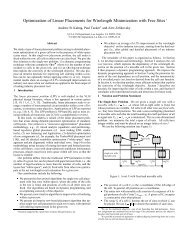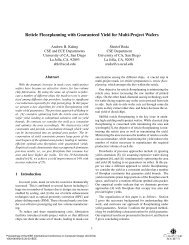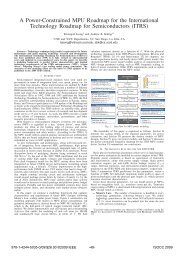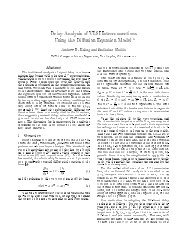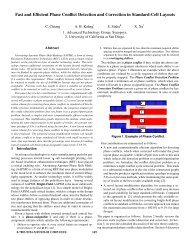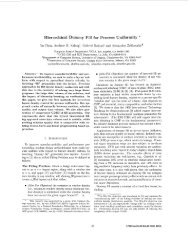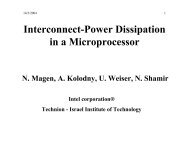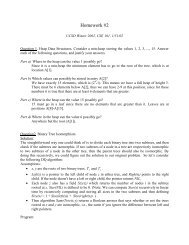Smart Non-Default Routing for Clock Power Reduction - UCSD VLSI ...
Smart Non-Default Routing for Clock Power Reduction - UCSD VLSI ...
Smart Non-Default Routing for Clock Power Reduction - UCSD VLSI ...
Create successful ePaper yourself
Turn your PDF publications into a flip-book with our unique Google optimized e-Paper software.
Cadence Encounter DIS v10.1 [24]. We solve the wire sizing problem<br />
<strong>for</strong>mulated above using Mathworks MATLAB R2012b [25].<br />
Insertion delay constraints are set by adding a small (5%) margin to<br />
the original insertion delay of each sink; this improves flexibility of<br />
the SNDR assignment with negligible impact on the final insertion<br />
delay, as shown in Table 4. We use the maximum skew of the original<br />
design as the skew constraint, and the maximum transition time<br />
of the original design with a margin (less than 5% of clock period)<br />
as the maximum transition time (slew) constraint. EM constraints<br />
are obtained from the Synopsys 32/28nm PDK. 10 For simplicity,<br />
we assume that the track constraint is a constant, i.e., we per<strong>for</strong>m an<br />
“iso-area” optimization; the corresponding set of NDRs is (4W5S),<br />
(3W6S), (2W7S) and (1W8S). We allow the optimization to use<br />
only smaller-width NDRs to replace the original NDR of the clock<br />
tree, i.e., we only taper the wire. The clock tree is initially routed<br />
with the maximum wire width NDR (4W5S). We note that in this<br />
particular technology, use of a smaller-width NDR in the initial<br />
implementation can result in EM violations after CTS.<br />
5.2 Experimental Results<br />
We have per<strong>for</strong>med the SNDR optimization on nine benchmark<br />
designs to assess capacitance and power reductions af<strong>for</strong>ded by use<br />
of SNDRs. Table 2 shows the number of instances, sinks and clock<br />
buffers <strong>for</strong> each testcase.<br />
Table 2: Testcases: number of instances, sinks and clock buffers.<br />
testcase #instances #sinks #clock buffers<br />
aes_cipher_top 21766 530 11<br />
eth_top 11342 1743 37<br />
jpeg_encoder 67185 4512 100<br />
mc_top 6525 934 27<br />
mpeg2_top 13026 2931 59<br />
tv80s 6478 359 25<br />
usbf_top 11446 1515 31<br />
wb_conmax_top 32559 770 25<br />
wb_dma_top 3035 523 15<br />
are independent of each other. Importing modified DEF back into<br />
the P&R tool never requires more than 10 seconds <strong>for</strong> any testcase.<br />
The “delta” values in the rightmost three columns of the table are<br />
reported in picoseconds, i.e., the insertion delay, slew and skew<br />
changes are negligible (moreover, negative delta values represent<br />
improvements in these parameters). We see that our SNDR flow<br />
can reduce clock wire capacitance over the conventional designs<br />
by up to 10.3% (average 9.2%) when (4W5S) is used as the fixed<br />
NDR. With the reduced wire capacitance, we achieve up to 5.7%<br />
(average 4.9%) and 4.2% (average 3.4%) clock switching power<br />
and total power savings 11 with essentially zero EM violations or<br />
timing degradations. We have also applied SNDRs <strong>for</strong> the case that<br />
(2W4S) is used as the fixed NDR. In this case, SNDRs have just<br />
two options, i.e., (2W4S) or (1W5S). Wire capacitances reduce by<br />
up to 5.9% (4.7% on average), which yields up to 2.8% (average<br />
2.2%) and 2.1% (average 1.5%) clock switching power and total<br />
power savings. We note that our results correspond to a viable flow<br />
implemented in a widely-used commercial EDA tool: all of the<br />
post-optimization SNDR-based clock routing is DRC-clean, and<br />
while the optimization is guided by our abstractions of delay and<br />
slew, all of the reported extraction and timing results, EM checks,<br />
etc. are according to the same commercial tool.<br />
Table 3: Results using SNDRs with an upper bound on track cost of 7.<br />
testcase track cost capacitance<br />
reduction (%) reduction (%)<br />
aes_cipher_top 53.8 12.15<br />
eth_top 46.8 13.14<br />
jpeg_encoder 48.1 12.37<br />
mc_top 49.1 12.45<br />
mpeg2_top 52.5 12.14<br />
tv80s 48.0 11.49<br />
usbf_top 48.1 11.11<br />
wb_conmax_top 49.7 13.16<br />
wb_dma_top 52.7 14.28<br />
Figure 8 shows the proportions of total clock wirelength routed<br />
with each NDR after applying our wire sizing optimization. From<br />
the results, we see that more than 80% of the wiring is replaced by<br />
smaller NDRs.<br />
wb_dma_top<br />
wb_conmax_top<br />
usbf_top<br />
tv80s<br />
mpeg2_top<br />
mc_top<br />
jpeg_encoder<br />
eth_top<br />
aes_cipher_top<br />
0% 20% 40% 60% 80% 100%<br />
1W8S<br />
2W7S<br />
3W6S<br />
4W5S<br />
Figure 8: Proportions of total clock tree wirelength routed with different NDRs<br />
after optimization.<br />
Table 4 shows the post-optimization implemented results and<br />
clock network power reduction versus the original (conventional)<br />
designs which use fixed NDRs of (4W5S) in Table 4(a) and (2W4S)<br />
in Table 4(b). Runtime <strong>for</strong> the MATLAB implementation of our<br />
algorithm is between 10 seconds and ∼100 minutes per subnet on a<br />
2.5GHz Intel Xeon processor; this runtime varies widely depending<br />
on the number of sinks, the number of wire segments, and the number<br />
of constraints. Each testcase requires sequential optimization of<br />
subnets, but it is simple to parallelize the solution of subnets that<br />
10 Maximum skew constraints of 3-18ps are used except <strong>for</strong> jpeg_encoder (110ps).<br />
Slew constraints of 47-100ps are used except <strong>for</strong> eth_top, jpeg_encoder, mpeg2_top<br />
(> 200ps). EM constraints are calculated using Equation (11).<br />
Last, to assess the potential <strong>for</strong> area recovery using various SNDRs,<br />
we per<strong>for</strong>m an additional study using a set of SNDRs which maintains<br />
track cost less than the original fixed NDR. That is, we explore<br />
“reduced-area” SNDRs of (1W2S), (2W4S) and (3W6S). While the<br />
original set of SNDRs all require 7 tracks, the new set of SNDRs<br />
requires ≤ 7 tracks. For example, a (1W2S) SNDR might be used<br />
where a (1W8S) SNDR was used in the previous experiment. We<br />
per<strong>for</strong>m the same optimization using characterized RC models <strong>for</strong><br />
the new set of SNDRs, with results summarized in Table 3. We see<br />
in the table that the new set of SNDRs actually achieves slightly<br />
improved capacitance reduction, while also saving up to 53.8% of<br />
routing tracks (49.9% on average), calculated as a weighted average<br />
along the entire routed wirelength of the clock tree.<br />
6. CONCLUSIONS<br />
The notion of wire tapering <strong>for</strong> clock tree (area, power, skew)<br />
optimization has been studied in the literature <strong>for</strong> nearly 20 years.<br />
However, tapering flows have not achieved traction in production<br />
IC implementation methodologies, possibly due to the lack of perceived<br />
benefit in combination with the complexity of flow development.<br />
For several reasons, we believe that wire width selection<br />
in CTS has become worth revisiting: clock power reduction<br />
is increasingly critical in a power-limited world; variability has<br />
driven CTS optimizations toward larger drivers and high-fanout<br />
clock nets; and EM reliability limits in particular (along with the<br />
desire to avoid time-consuming EM-fix steps in physical design)<br />
have motivated the widespread use of NDRs in modern CTS methodologies.<br />
11 <strong>Clock</strong> buffers and FFs are not changed. The power savings are achieved only with<br />
wire capacitance reduction.




